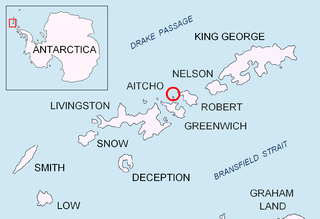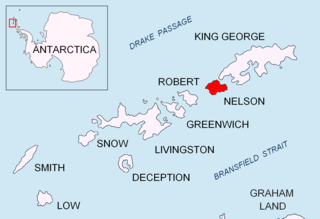
The Aitcho Islands are a group of minor islands on the west side of the north entrance to English Strait separating Greenwich Island and Robert Island in the South Shetland Islands, Antarctica, which are situated between Dee Island to the south and Table Island to the north. The group is separated from Dee Island and Sierra Island to the southwest by Villalón Passage. The area was visited by early 19th century sealers operating from nearby Clothier Harbour. During the austral summer the islands are often visited by Antarctic cruise ships with tourists who land to watch wildlife.

Shearer Stack is a rock stack lying 1.5 miles (2.4 km) southwest of False Round Point, off the north coast of King George Island in the South Shetland Islands. Named by the United Kingdom Antarctic Place-Names Committee (UK-APC) in 1960 for the American sealing vessel Charles Shearer from Nantucket, which visited the South Shetland Islands in 1874-75. In 1877 the ship again sailed for the islands and disappeared without a trace.

Holmes Rock is rising to 45 m (49 yd) north of Greenwich Island and west of Aitcho group in the South Shetland Islands, Antarctica. The area was visited by early 19th century sealers.

Morris Rock is rising to 55 m (180 ft) in the northwest extremity of Aitcho group, English Strait in the South Shetland Islands, Antarctica. The area was visited by early 19th century sealers.

Long Rock is a large rock extending 720 m (787 yd) in east-west direction, 180 m (197 yd) wide and rising to 13 m (42.7 ft) in the northeast of Morton Strait in the South Shetland Islands, Antarctica. The area was visited by early 19th century sealers operating on Byers Peninsula.

Henfield Rock is an offshore rock lying northwest of Robert Island in the South Shetland Islands, Antarctica. It was known to the early 19th century sealers operating from nearby Clothier Harbour, and sometimes included under the name 'Powels Islands' or 'Heywood Islands'.

Caraquet Rock is a rock lying nearly 4 nautical miles (7 km) west-southwest of Bell Point, off the west part of King George Island in the South Shetland Islands. It was named by the UK Antarctic Place-Names Committee in 1960 for the sealing vessel Caraquet from Liverpool, which visited the South Shetland Islands in 1821–22.

Upton Rock is a rock lying 3 nautical miles (6 km) northwest of Flat Top Peninsula, King George Island, in the South Shetland Islands. Named by the United Kingdom Antarctic Place-Names Committee (UK-APC) in 1961 for Benjamin Upton, Master of the American sealing vessel Nancy from Salem, MA, which visited the South Shetland Islands in 1821-22.

Nancy Rock is a rock lying 2 nautical miles (3.7 km) west of Flat Top Peninsula, King George Island, in the South Shetland Islands. Named by the United Kingdom Antarctic Place-Names Committee (UK-APC) in 1961 after the American sealing vessel Nancy from Salem, MA, which visited the South Shetland Islands in 1820-22.

Grace Rock is a rock in Bransfield Strait, Antarctica lying 1.72 kilometres (0.93 nmi) off the southeast coast of Nelson Island in the South Shetland Islands. It was named by the UK Antarctic Place-Names Committee in 1961 after the British sealing vessel Grace from Plymouth, which visited the South Shetland Islands in 1821–22.

Pig Rock is a rock, 65 m high, the largest of a group of rocks lying 1.9 kilometres (1 nmi) east of the east end of Nelson Island, in the South Shetland Islands. This rock, known to sealers in the area as early as 1821, was charted and named by DI personnel on the Discovery II in 1935.

Folger Rock is a rock lying 2.5 nautical miles (5 km) north of Harmony Point, Nelson Island, in the South Shetland Islands. It was named by the UK Antarctic Place-Names Committee in 1961 for Tristan Folger, the Master of the American sealing vessel William and Nancy from Nantucket, which visited the South Shetland Islands in 1820–21, operating from nearby Harmony Cove.

Livonia Rock is a rock lying 0.5 nautical miles (1 km) south of Cape Melville, the eastern extremity of King George Island, in the South Shetland Islands, Antarctica. It was named by the UK Antarctic Place-Names Committee in 1960 for the sealing vessel Livonia from London, which visited the South Shetland Islands in 1821–22.

Hauken Rock is a rock lying nearly 1 nautical mile (2 km) east of the Ornen Rocks and 2 nautical miles (4 km) northeast of Cape Melville, the eastern extremity of King George Island, in the South Shetland Islands. It was named by the UK Antarctic Place-Names Committee in 1960 from association with Ornen Rocks. Hauken and Ørnen, the first two modern whale catchers, accompanied the floating factory ship Admiralen to the South Shetland Islands in January–February 1906.

Sail Rock is the remaining uppermost part of a submerged volcanic edifice lying 7 nautical miles (13 km) southwest of Deception Island in the South Shetland Islands, Antarctica. It is 20 m long in southwest-northeast direction, 12 m wide and 30 m high. From a distance, the rock is reported to resemble a ship under sail, but at close range it is more like a house with a gable roof. The feature's name, which dates back to at least 1822, was probably given by sealers.

Vodoley Rock is the rock extending 220 m in northwest-southeast direction and 110 m wide in Barclay Bay on the west side of Ioannes Paulus II Peninsula on Livingston Island in the South Shetland Islands, Antarctica. The area was visited by early 19th century sealers operating on nearby Byers Peninsula and Cape Shirreff.

Perivol Rock is the rock off Snow Island in the South Shetland Islands, Antarctica, extending 230 m in a southeast–northwest direction and 170 m wide.

Meldia Rock is the rock of diameter 220 m and split in east-west direction, lying off the northwest coast of Nelson Island in the South Shetland Islands, Antarctica. The area was visited by early 19th century sealers.

Bekas Rock is the 140 m long in southwest-northeast direction and 60 m wide rock lying west of Rugged Island on the west side of Livingston Island in the South Shetland Islands, Antarctica. The area was visited by early 19th century sealers.













